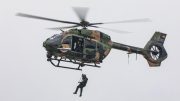The Shared Air Traffic Services System 2 (SAS2) has been put into service by the Belgian Ministry of Defence. The Belgian military air traffic controllers and the civil air traffic controllers at EUROCONTROL’s Maastricht Upper Area Control Centre (MUAC) are now working with a single air traffic management (ATM) system, which is fully in line with Single European Sky (SES) objectives.
Air traffic control services in Belgian and Luxembourg airspace are provided by three independent organisations: the Belgian Ministry of Defence for military operational air traffic (OAT), and skeyes and MUAC for civil general air traffic (GAT) in lower and upper airspace (as the latter from 24,500 feet) respectively.
Until recently, each of these organisations worked with its own air traffic control system, managed independently of the other two organisations. With the commissioning of the SAS2 system by the Belgian Ministry of Defence on 2 December 2019, the Belgian Ministry of Defence and MUAC now work with the same system. The advantages of a shared ATS system are numerous for both organisations: better coordination between civil and military controllers at both ends, improved situational awareness and safety, better communication, economies of scale, system agreements, shared tools, and joint software/hardware upgrades, all of which will ultimately lead to better performance.
Following the signature of the cooperation agreement between the Ministry of Defence and MUAC in December 2016, the SAS2 system was fully developed over the last three years in order to integrate the required military air traffic control functionalities into MUAC’s existing air traffic control system.
The required hardware was installed at the skeyes site in Steenokkerzeel and at the airbases of Beauvechain, Kleine-Brogel, Koksijde and Florennes.
A first major step towards the commissioning of the SAS2 system was taken in March 2019 when the site acceptance test was successfully carried out. This confirmed that the SAS2 system could provide safe air traffic control services, both at the various military sites and at MUAC.
In addition, intensive training was provided for both the military air traffic controllers and the technicians on the use and maintenance of this new system.
In November 2019, shadow operations (off-line operations) took place, during which all actions carried out by the military air traffic controllers on the old ATS system (SEROS for ATCC and LATC for the air bases) were copied to the SAS2 system. Shadow operations confirmed that the SAS2 system contains all the functionalities required by the military air traffic controllers and was therefore ready to go live. At the close of the shadow operations, minor modifications were made to the SAS2 system and it was confirmed that the system was ready to be used for *limited[1] military air traffic control as from 2 December 2019. Ultimately, the SAS2 system will support all military air traffic control (final operational capability) by March 2020.
The commissioning of the SAS2 system by the Belgian Ministry of Defence coincides with the move of the military air traffic control centre to the skeyes site in Steenokkerzeel. In parallel, a study was launched by the Ministry of Defence, MUAC and skeyes to replace skeyes’ current air traffic control system with a shared ATS system – SAS3 – by 2025. This would allow the three organisations managing Belgian/Luxembourg airspace to use a single air traffic control system in order to achieve better cooperation in their services, thereby contributing to the Single European Sky (SES) objectives.
“The Directorate General Material Resources can only confirm the benefits of this partnership,” said Lieutenant General Rudy Debaene. “Far beyond the economic benefits and those obtained by reducing the number of specialised military technicians, this cooperation represents a major step forward in the management of Belgian airspace. It is being done more efficiently and in a safer way by two of the three actors managing the airspace.”
John Santurbano, Director of MUAC, added: “The Shared ATS System is based on a proven Virtual Centre Concept developed and deployed by MUAC across various Royal Netherlands Air Force sites in 2013 and at the Slovenia Control Centre. The system is robust, and we have every confidence that our Belgian colleagues have made a good choice. As MUAC facilities are upgraded and/or developed to SESAR standards, the improvements will automatically flow to the Belgian military air defence sites served from MUAC, securing economies of scale through common development and maintenance resources.”
Major General Vansina, Commander of the Air Component, concluded: “Working together on the same system will facilitate coordination and communication, which will only benefit flight safety.”
SAS2 is co-financed by the Connecting Europe Facility (CEF), an EU funding instrument to promote growth, jobs and competitiveness through targeted infrastructure investment at European level. The CEF programme budget is implemented for the most part by the EU Innovation and Networks Executive Agency (INEA).
[1] Limited military air traffic control means that the transition to the new ATC system imposes a number of restrictions on the number of MIL aircraft which can operate simultaneously in certain sectors. Restrictions are also imposed on the type of mission which can be flown. These restrictions will be systematically lifted in order to ensure a full ATC service using SAS2 by the end of March 2020 at the latest.







Be the first to comment on "Civil and military air traffic control in Belgium now managed using a single air traffic management system"